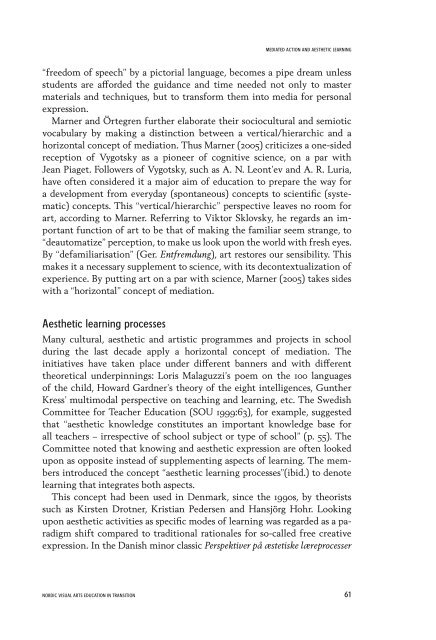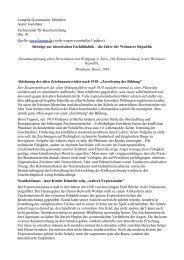Research in Visual Arts Education - The National Society for ...
Research in Visual Arts Education - The National Society for ...
Research in Visual Arts Education - The National Society for ...
Create successful ePaper yourself
Turn your PDF publications into a flip-book with our unique Google optimized e-Paper software.
MEDIATED ACTION AND AESTHETIC LEARNING<br />
“freedom of speech” by a pictorial language, becomes a pipe dream unless<br />
students are af<strong>for</strong>ded the guidance and time needed not only to master<br />
materials and techniques, but to trans<strong>for</strong>m them <strong>in</strong>to media <strong>for</strong> personal<br />
expression.<br />
Marner and Örtegren further elaborate their sociocultural and semiotic<br />
vocabulary by mak<strong>in</strong>g a dist<strong>in</strong>ction between a vertical/hierarchic and a<br />
horizontal concept of mediation. Thus Marner (2005) criticizes a one-sided<br />
reception of Vygotsky as a pioneer of cognitive science, on a par with<br />
Jean Piaget. Followers of Vygotsky, such as A. N. Leont’ev and A. R. Luria,<br />
have often considered it a major aim of education to prepare the way <strong>for</strong><br />
a development from everyday (spontaneous) concepts to scientific (systematic)<br />
concepts. This “vertical/hierarchic” perspective leaves no room <strong>for</strong><br />
art, accord<strong>in</strong>g to Marner. Referr<strong>in</strong>g to Viktor Sklovsky, he regards an important<br />
function of art to be that of mak<strong>in</strong>g the familiar seem strange, to<br />
“deautomatize” perception, to make us look upon the world with fresh eyes.<br />
By “defamiliarisation” (Ger. Entfremdung), art restores our sensibility. This<br />
makes it a necessary supplement to science, with its decontextualization of<br />
experience. By putt<strong>in</strong>g art on a par with science, Marner (2005) takes sides<br />
with a “horizontal” concept of mediation.<br />
Aesthetic learn<strong>in</strong>g processes<br />
Many cultural, aesthetic and artistic programmes and projects <strong>in</strong> school<br />
dur<strong>in</strong>g the last decade apply a horizontal concept of mediation. <strong>The</strong><br />
<strong>in</strong>itiatives have taken place under different banners and with different<br />
theoretical underp<strong>in</strong>n<strong>in</strong>gs: Loris Malaguzzi’s poem on the 100 languages<br />
of the child, Howard Gardner’s theory of the eight <strong>in</strong>telligences, Gunther<br />
Kress’ multimodal perspective on teach<strong>in</strong>g and learn<strong>in</strong>g, etc. <strong>The</strong> Swedish<br />
Committee <strong>for</strong> Teacher <strong>Education</strong> (SOU 1999:63), <strong>for</strong> example, suggested<br />
that “aesthetic knowledge constitutes an important knowledge base <strong>for</strong><br />
all teachers – irrespective of school subject or type of school” (p. 55). <strong>The</strong><br />
Committee noted that know<strong>in</strong>g and aesthetic expression are often looked<br />
upon as opposite <strong>in</strong>stead of supplement<strong>in</strong>g aspects of learn<strong>in</strong>g. <strong>The</strong> members<br />
<strong>in</strong>troduced the concept “aesthetic learn<strong>in</strong>g processes”(ibid.) to denote<br />
learn<strong>in</strong>g that <strong>in</strong>tegrates both aspects.<br />
This concept had been used <strong>in</strong> Denmark, s<strong>in</strong>ce the 1990s, by theorists<br />
such as Kirsten Drotner, Kristian Pedersen and Hansjörg Hohr. Look<strong>in</strong>g<br />
upon aesthetic activities as specific modes of learn<strong>in</strong>g was regarded as a paradigm<br />
shift compared to traditional rationales <strong>for</strong> so-called free creative<br />
expression. In the Danish m<strong>in</strong>or classic Perspektiver på æstetiske læreprocesser<br />
NORDIC VISUAL ARTS EDUCATION IN TRANSITION 61



